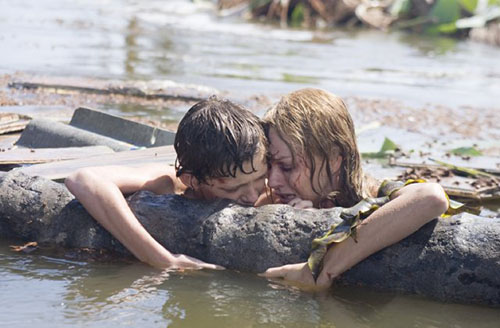Review: The Impossible
 December 24 marked the eighth anniversary of one of the deadliest natural disasters in recorded history, an underwater earthquake in the Indian Ocean off the coast of Sumatra, Indonesia, that triggered a series of tsunamis. Over 230,000 people were killed in 14 countries that encompass the Indian Ocean, mostly in the coastal communities of Indonesia, Sri Lanka, India, and Thailand. In 2004 I followed the tragic stories of survival and loss, not just from media but also from "citizen reports" that streamed out from tourists and humanitarian aid workers. The stories included lists of orphaned native children and found young Europeans, separated from their families.
December 24 marked the eighth anniversary of one of the deadliest natural disasters in recorded history, an underwater earthquake in the Indian Ocean off the coast of Sumatra, Indonesia, that triggered a series of tsunamis. Over 230,000 people were killed in 14 countries that encompass the Indian Ocean, mostly in the coastal communities of Indonesia, Sri Lanka, India, and Thailand. In 2004 I followed the tragic stories of survival and loss, not just from media but also from "citizen reports" that streamed out from tourists and humanitarian aid workers. The stories included lists of orphaned native children and found young Europeans, separated from their families.
Spanish physician and tsunami survivor Maria Belon recounted her family's personal story on the radio, inspiring producer Belen Atienza (Pan's Labyrinth, The Orphanage) to portray the Belons' experience on the big screen. The result is the harrowing drama The Impossible from the filmmaking team behind the tragic horror story The Orphanage, including writer Sergio G. Sanchez and director Juan Antonio Bayona.
Naomi Watts stars as Maria and Ewan McGregor as Henry, a British couple vacationing with their three sons at a resort in Thailand during the Christmas holidays. Within a few minutes of the movie's opening, disaster strikes and the family is separated by the massive waves. A critically injured Maria is reunited with her son Lucas (Tom Holland) and the pair struggle through the aftermath to find medical assistance and the rest of their family.
The Impossible is not heavy with dialogue, relying more on Sanchez's writing and Bayona's direction to demonstrate the emotional and physical toll of both the disaster and the main characters' loss of their loved ones. The technical effects are quite impressive -- through the use of the second largest water tank in the world and miniatures, the dramatization of the waves and subsequent flooding is quite authentic. The cinematography effectively captures the chaos of local rural clinics overwhelmed with the injured and dying, as well as the isolation of children separated from their parents. Much of the film was actually shot on locations in Thailand where events occurred, and most of the extras were tsunami survivors.
Watts has already and rightly garnered a best female dramatic performance award nomination for the 2013 Golden Globe awards. Her transformative portrayal -- supported by realistic special makeup effects -- evokes a gamut of emotional responses from viewers as she incurs injuries and her health deteriorates. Holland's acting brings an unexpected level of maturity to his role as the young son who must ensure his mother's safety and survival at the same time he searches for his father and siblings. McGregor's performance is adequate for his limited screen time, but it's Watts and Holland that are the star performers.
Viewers unfamiliar with the effects of a natural disaster in a rural area might assume that The Impossible is an over-exaggeration, but from my own personal observations and experiences -- being isolated in a remote area of Costa Rica in 1996 during Hurricane Cesar-Douglas -- I can attest to the authenticity of this portrayal. The filmmakers capture one of the most critical lessons in this film to be learned, and that is respect for the sheer force of nature especially of the ocean. Even more importantly, The Impossible demonstrates the importance of family bonds. I highly recommend seeing this film, but some scenes may be too disturbing for younger viewers.

